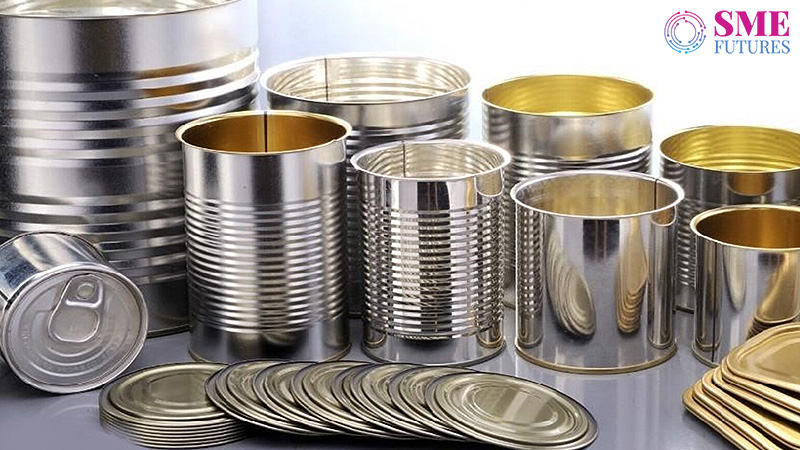Despite having adequate capacity to manufacture tinplate to meet domestic demand, India imports 35-40 per cent of its requirement of tinplate, much of it of low quality that finds its way into food packaging.
The genesis of tinplate cans made from steel sheets with a Tin coating has a history of more than 200 years. They evolved as armed forces sought a way to preserve and carry rations for their military campaigns. Tinplate was chosen as the packaging medium due to its excellent barrier properties (oxygen, bacteria, and sunlight), mechanical strength, high shelf life and ability to retain nutritional values of food.
The canned food revolution took off after technological advancements led to high-speed manufacturing, filling, and re-closing cans. It became possible with the modern steel companies investing in developing thinner and stronger steel making the cans lighter.
The product of war from two centuries ago has become a battle in India over tariffs, duties, and quality standards. When used for packaging food, higher-grades of tinplate are recommended by regulators, including the Food Safety and Standards Authority of India (FSSAI), as low-quality tinplate may contaminate food.
Despite having adequate capacity to manufacture tinplate for Indian demand, India imports 35-40 per cent of its requirement of tinplate, much of it of low quality that indeed finds its way into food packaging. Nearly 70 per cent of tinplate used in India is for packing foods, and 80 per cent of imports by India are non-prime and low quality. Almost 25 per cent of the non-prime low-grade tinplate produced globally is dumped into India every year, causing severe health and safety hazards to a large population.
Quality control order
Cheap grades of tinplate are banned in developed economies, and as a result, they get dumped in India. The government of India had sought to prevent the use of non-prime tinplate in food cans through the Steel and Steel Product Quality Control Order (SSPQCO) dated July 17, 2020. The implementation has, however, been deferred twice.
Around 145 Indian standards have been notified under the Quality Control Order covering various carbon and alloy steel products. While these orders for some steel categories were issued as early as 2009, standards for tinplate have been delayed despite instances of the use of low-grade tinplate food packaging coming to light.
An anti-dumping investigation, carried out by Director General (Trade Remedies) in 2020, corroborated the above facts and found that imports were being dumped into India at unfair prices, causing injury to the domestic tin-mills. It had since proposed anti-dumping duty ranging between $222-334 per tonne on tinplate imports from countries such as the US, EU, Korean Republic, and Japan (except Nippon steel). The anti-dumping duty recommendation has not been implemented.
Domestic capacity
While tinplate demand in India was around 0.6 million tonnes in FY 2020-21, domestic installed capacity is at 0.73 million tonnes, which is enough for domestic demand. The virtual free access to the Indian tinplate market for cheap imports has led to Indian tinplate mills running at 70 per cent capacity. In the last three years, it has also led to the closure of close to 0.15 million tonnes of indigenous capacity.
In line with the government’s “Atmanirbhar” initiative, the domestic industry will add another 0.29 million tonnes of fresh capacity by the end of 2021-22. Not finding buyers in the country, the Indian manufacturers have tried to diversify by exporting 15-20 per cent of their production, meeting global benchmarks.
In addition, the Industry imports both prime and non-prime materials to manufacture tin containers and other goods for the food and non-food industries. Industry can use non-prime material to manufacture tin containers for non-edible products like paints, chemicals, and other products like stationery items, lanterns, etc. Non-prime material arises when the tinplate mills produce prime material and is categorised as non-prime due to thickness variation, surface defect, etc.
These commercially cheaper materials can be conveniently used in India, where the availability of labour is comparatively cost-efficient, and the cans/ products are manufactured either manually or in a semi-automatic process. In the case of imposition of BIS, such non-prime material will not be available to the metal packaging units in MSME sectors. It means that they will have to depend on the prime material, which is approximately —35% more expensive than the non-prime material and is already in short supply.
Considering the market is already favouring the industry in terms of demand. However, now much is dependent on government policies as soon as it becomes favourable, it will pin a promising future for the Indian metal packaging industry.
By withdrawing the mandatory certification, the foreign suppliers will restart shipping Tin plates to India as, at present, there is a considerable shortage in the domestic market.
Furthermore, to make the environment more conducive and promote the localisation of steel products, the government should set up a soft loan payable in more than ten years for the packaging industry.
Also, since metal packaging is 100% recyclable, environment friendly, and sustainable packaging material, the government should take out a scheme to incentivise the user industry to encourage such packaging material.
Tinplate is a recyclable and sustainable packaging material, and the Covid-19 pandemic has underlined its importance and demand for packaged food cans has surged. The food processing industry has also got a boost.
However, the rampant use of cheaper non-prime tinplate continues to be a dampener in India, posing a threat to the health and safety of the Indian population at large. It is time for India to recognise the danger and ban the usage of non-prime tinplate, like other developed economies.











